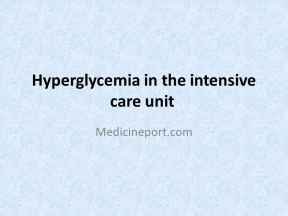Hyperglycemia and insulin resistance are common in critically ill patients even if they did not have diabetes before their illnesses.
Hyperglycemia in the intensive care unit (ICU) setting has been shown to be associated with an increased mortality, and restoration of nor-moglycemia using intensive insulin therapy has decreased mortality for the following populations:myocardial infarction, burn, and stroke.
 Specifically, in the surgical ICU setting, the use of intensive insulin therapy to achieve nor-moglycemia in hyperglycemia in the intensive care unit has resulted in a lower incidence of nosocomial infections.
Specifically, in the surgical ICU setting, the use of intensive insulin therapy to achieve nor-moglycemia in hyperglycemia in the intensive care unit has resulted in a lower incidence of nosocomial infections.
The most compelling study by Van den Berghe et al. showed that, for hyperglycemia in the intensive care unit setting on the ventilator, intensive insulin therapy to achieve normoglycemia (80 to 110 mg/dL = 4.4 to 6.1 mmol/L) resulted in a 43% reduction in mortality (8% compared with 4.6%) when compared with patients treated with sliding scale insulin with the aim of achieving a glucose level between 180 and 200 mg/dL (10.0 to 11.1 mmol/L).
The lowered mortality was largely accounted for in the group with an ICU stay of more than 5 days whose mortality from multiple organ failure was lowered.
Additional outcomes associated with normoglycemia included fewer bacteremias, reduced requirement for hemodialysis, fewer transfusions, and shorter duration on the ventilator and in the ICU.
 Although hyperglycemia in the intensive care unit population was skewed toward postoperative cardiac surgery patients, the-ICU-stay population in whom the mortality reduction was more striking, and therefore a better balanced group.
Although hyperglycemia in the intensive care unit population was skewed toward postoperative cardiac surgery patients, the-ICU-stay population in whom the mortality reduction was more striking, and therefore a better balanced group.
Accordingly, the currently available evidence favors aiming for normoglycemia (blood glucose level of less than 110 mg/dL = 6.1 mmol/L) through intravenous insulin infusion in adult surgical ICU patients. It has not been proven that the same improved outcomes will be found in nonadult or nonsurgical ICU patients.
The use of intensive insulin infusion can result in hypoglycemia either from excess insulin or from improvement in the patients conditions (with a fall in insulin resistance).
 Many ICUs counteract this risk of hypoglycemia by also placing the patient on an infusion of dextrose during insulin administration for hyperglycemia in the intensive care unit .
Many ICUs counteract this risk of hypoglycemia by also placing the patient on an infusion of dextrose during insulin administration for hyperglycemia in the intensive care unit .
Frequent blood glucose monitoring (on the order of hourly) is an important part of the treatment protocol in insulin infusion to avoid hypoglycemia.
For more read the following:
Impact of admission hyperglycemia on hospital mortality
